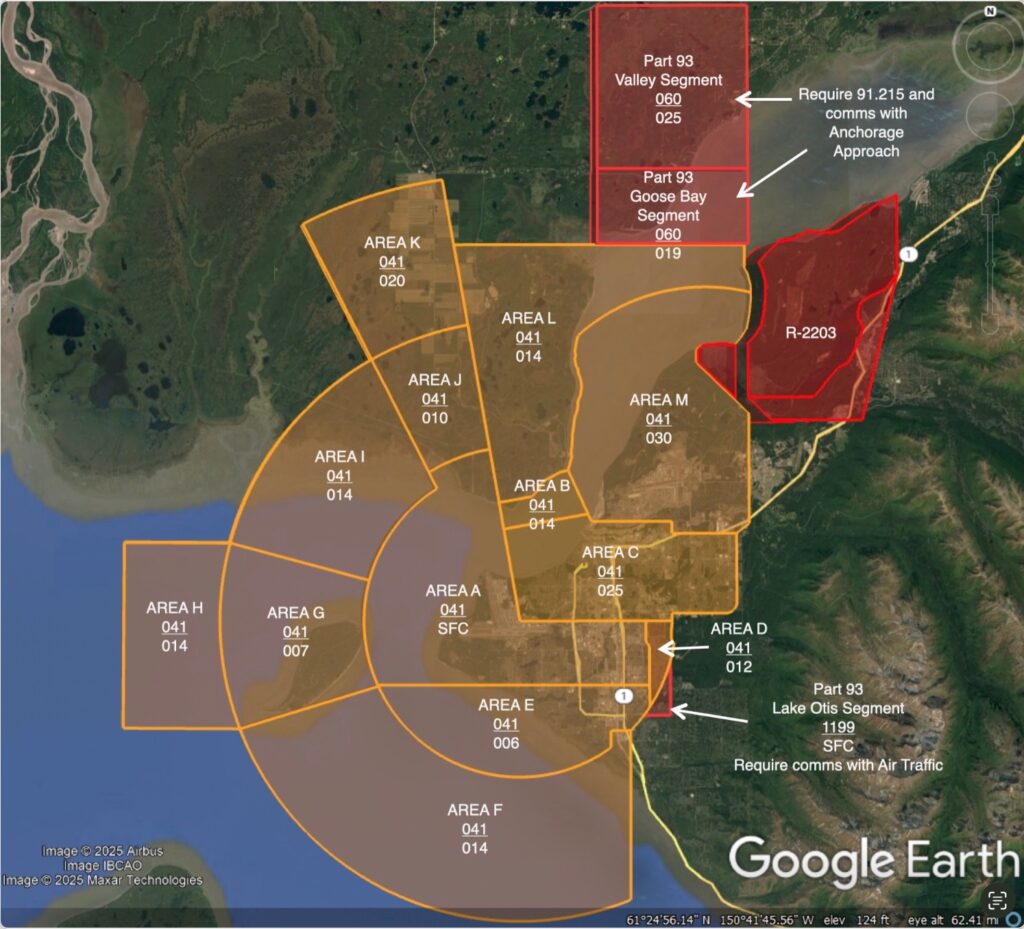Changes could be on the horizon for pilots flying in and out of Ted Stevens Anchorage International Airport, as the Federal Aviation Administration begins taking public input on a proposal to redraw Class C airspace in the Anchorage area. The changes are expected to be significant in the Anchorage bowl. Pilots will need to do their homework because the patterns will change.
The Federal Aviation Administration will hold two virtual public meetings in September to gather feedback on a proposal to amend Class C airspace at Ted Stevens.
The meetings, set for Sept. 23-24, will air the traffic challenges that may come when the Air Force’s 3rd Wing at Joint Base Elmendorf-Richardson extends runway 16/34 by 2,500 feet and installs an Instrument Landing System, with plans to make it the primary arrival runway.
FAA studies have found that while the upgrades would enhance safety and operational efficiency, they could also cause delays across the region’s airports, including Ted Stevens International, Merrill Field, and Elmendorf.
To mitigate potential impacts, the FAA is reviewing possible redesigns of local airspace and flight procedures. This includes evaluating instrument approaches, air traffic flows, and classifications for Class C and D airspace, as well as special Anchorage Terminal Area flight rules.
Class C airspace is a type of controlled airspace established around airports with moderate traffic levels, such as Ted Stevens Anchorage International Airport, to manage air traffic and ensure safety. It is designed to handle a mix of commercial, general aviation, and sometimes military operations, with specific rules to regulate aircraft movement.
Class D airspace is a type of controlled airspace surrounding airports with an operational control tower but typically lower traffic volume than those with Class B or Class C airspace, such as smaller regional or general aviation airports. It is designed to manage air traffic and ensure safety in the vicinity of these airports. Merrill Field is considered Class D. Lake Hood, the world’s busiest seaplane base, shares a control tower with ANC but operates its own Class D airspace for seaplane and general aviation operations. Its airspace extends from the surface to a similar altitude as Merrill Field’s, with a radius tailored to its operations.
An Ad Hoc Committee led by the Alaska Department of Transportation has helped shape proposed redesigns. Those designs have been shared first through the committee process, with the public’s initial opportunity for feedback coming at the airspace meetings.

Meeting attendees will be able to present comments, ask questions, and submit written materials. Both sessions will be recorded and made available on the FAA’s YouTube channel.
Comments can be sent to: Byron G. Chew, FAA Western Service Center, 2200 S. 216th St., Des Moines, WA 98198, or by email to [email protected] (subject line: “ANC Class C”).
A graphic depiction of the proposed airspace changes is available at this FAA link.
To attend the meeting on Sept. 23, , the public can register here: https://airportnetwork.zoom.us/webinar/register/WN_OexfJCRtQ7uhClNvgKalkA. To attend the meeting on Sept. 24, the public can register here: https://airportnetwork.zoom.us/webinar/register/WN_P8ziBn0zTSCsaF1qs9u_9g.
Notice of the public meeting was posted in the Federal Register at this link.

Considering the current state of Anchorage with its crime and homelessness, I’ll only be thinking of departures and will avoid approaching at all costs.
This must be the government’s response after the military chopper hit a commercial jet at Reagan International Airport earlier this year.
Naturally the meeting will be held on the last days of moose hunting season when the pilots most affected will be in the field.
Yeah, I’m pretty sure moose hunting was not considered by the Secret Service or whoever
There are a small handful of archery moose seasons that are open during this time, the vast majority of moose seasons statewide do not open until after this meeting.
I second Joseph Pazsint’s comment: of course the government doesn’t take into consideration that September is the month where most pilots log the most hours. Another case of either designing it that way so fewer people attend or the organizers are oblivious to the private pilots activities that use this airspace.
They’d not oblivious to them, just hostile to them
The missed approach from JBER RWY 16 is a huge problem because a decision to go around or make a missed approach will result in large aircraft climbing out southbound over east Anchorage and often into Merrill Field airspace.
Leave the RWY 6 precision approach airspace and procedures as is, stop the creation and construction of a precision approach to RWY 16. Stop it NOW before all the contracts are funded, with your taxes, for something totally unnecessary and certainly problematic. When you change something, change it for the better!